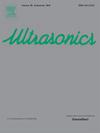A novel design for double-bending elliptical vibration boring device and its performance evaluation
IF 4.1
2区 物理与天体物理
Q1 ACOUSTICS
引用次数: 0
Abstract
Steel precision matching parts are widely used in aerospace and automobiles. In order to ensure the stability of the system, the matching parts’ mating surfaces, such as inner holes and outer shafts, are required to achieve nano-surface roughness and submicron-shape accuracy. Diamond-cutting technology is generally used for ultra-precision machining processes. However, it is not suitable for machining steel due to the active chemical reactions. Ultrasonic elliptical vibration cutting technology can significantly reduce the cutting heat to suppress the chemical wear of diamond tools. Consequently, this study proposes a novel simple theory-simulation design method for an ultrasonic elliptical vibration boring (UEVB) device. The device works in two six-order bending vibration modes, generating an elliptical tool motion in the plane determined by the nominal cutting direction and the cutting depth direction. Through the impedance test, frequency sweep test, and amplitude test, the test results of the device match well with the simulation results. The experimental results of cutting S136 steel show that the UEVB technology suppresses system chatter by 10 % and reduces surface roughness Ra by 72 % compared with common boring. Additionally, the tool has much light wear and the machined surface roughness is Ra 11.3 nm, which realizes the ultra-precision cutting of steel by diamond tools. Furthermore, the roundness of the processed hole, with a diameter of 30 mm, reaches 0.473 μm, which is significantly better than the highest standard grade G1 (0.5 μm). These results verify the feasibility of the proposed method.
双弯曲椭圆振动镗削装置的新设计及性能评价。
钢制精密配套件广泛应用于航空航天、汽车等领域。为了保证系统的稳定性,要求匹配零件的配合表面,如内孔和外轴,达到纳米级的表面粗糙度和亚微米级的形状精度。金刚石切削技术一般用于超精密加工过程。但由于化学反应活跃,不适合加工钢。超声椭圆振动切削技术可以显著降低切削热,抑制金刚石工具的化学磨损。因此,本研究提出了一种新的、简单的超声椭圆振动镗削装置理论仿真设计方法。该装置工作在两种六阶弯曲振动模式下,在公称切削方向和切削深度方向确定的平面上产生椭圆刀具运动。通过阻抗测试、扫频测试和幅值测试,器件的测试结果与仿真结果吻合良好。对S136钢的切削实验结果表明,与普通镗削相比,UEVB技术可抑制系统颤振10%,使表面粗糙度Ra降低72%。刀具磨损小,加工表面粗糙度为Ra 11.3 nm,实现了金刚石刀具对钢的超精密切削。加工后直径为30 mm的孔圆度达到0.473 μm,明显优于最高标准等级G1 (0.5 μm)。这些结果验证了所提方法的可行性。
本文章由计算机程序翻译,如有差异,请以英文原文为准。
求助全文
约1分钟内获得全文
求助全文
来源期刊

Ultrasonics
医学-核医学
CiteScore
7.60
自引率
19.00%
发文量
186
审稿时长
3.9 months
期刊介绍:
Ultrasonics is the only internationally established journal which covers the entire field of ultrasound research and technology and all its many applications. Ultrasonics contains a variety of sections to keep readers fully informed and up-to-date on the whole spectrum of research and development throughout the world. Ultrasonics publishes papers of exceptional quality and of relevance to both academia and industry. Manuscripts in which ultrasonics is a central issue and not simply an incidental tool or minor issue, are welcomed.
As well as top quality original research papers and review articles by world renowned experts, Ultrasonics also regularly features short communications, a calendar of forthcoming events and special issues dedicated to topical subjects.
 求助内容:
求助内容: 应助结果提醒方式:
应助结果提醒方式:


